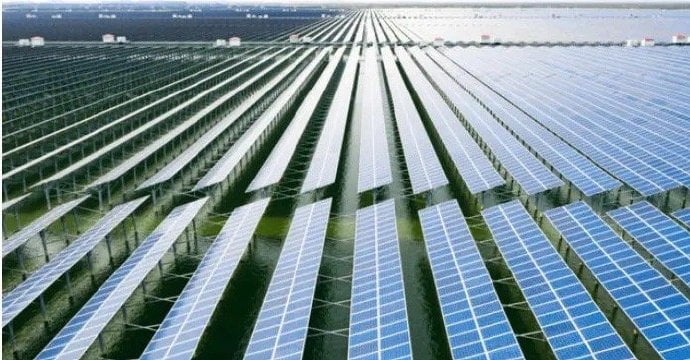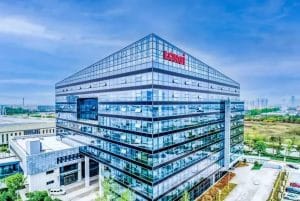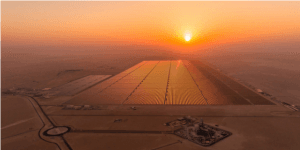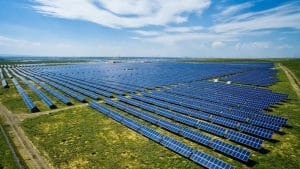The overcapacity in the photovoltaic industry has become so serious that the entire industry is losing money, which has become the most prominent problem in the photovoltaic industry.
But why is this happening?
Longi clearly pointed out at the Shanghai exhibition in May last year that the industry has a serious overcapacity and more than half of the companies will withdraw. However, its capacity expansion is not ambiguous at all. It has planned a capacity plan of 45 billion at one time. Tongwei also pointed out at the Sichuan Photovoltaic Conference in the second half of last year that the industry has overcapacity, and Tongwei has planned at least 60 billion investment plans in 2023.
Zhonghuan has always insisted on issuing bonds to invest in battery production capacity despite three inquiry letters from the Shenzhen Stock Exchange under the policy environment of tightening financing. Zhonghuan has always taken specialization as its strategy and clearly stated that it will never invest in batteries to compete with its own customers. Hesheng Silicon Industry has just prepared to enter the photovoltaic industry and has planned 400,000 tons of silicon materials at one time. Even photovoltaic glass has been planned at one time.
Don’t you know that the capacity is already seriously overcapacity? Or do you not know that the consequence of serious overcapacity is that everyone has a hard time. Who can invest billions of dollars is not a social elite? It can be said that no snowflake is innocent under the avalanche. So what is the reason behind such moth-to-flame irrational behavior? What is its business motivation? We need to think seriously.
1. The underlying logic of the industry for large-scale capacity expansion
1. The need for business development
Data shows that the module shipments of the leading integrated enterprises in 2021 will be 20GW (Longi will be higher at 38GW, rising to 40GW in 2022 and estimated to reach 60GW in 2023. The industry growth rate in 2024 will be 20% to 30%. Considering the competitive advantages of leading enterprises and the improvement of industry concentration, the module shipments of leading enterprises can reach a historical high of 80GW. Jinko’s shipment target is 100GW to 110GW. Due to the long time period for the expansion of photovoltaic capacity and the long time for climbing, it is necessary to arrange the capacity planning in advance so as not to affect the normal development of the company’s business. At the minimum, the five leading enterprises will increase 20GW in the silicon wafer, battery cell and module links, which means 100GW of new capacity each
2. The need to improve the integrated layout
The integrated strategy of the photovoltaic industry has the advantages of supply chain security, cost protection and operational efficiency. Reference Dr. Qiu of Tongwei got a PPT. His surname should be correct. I can’t remember his specific name. He made a comprehensive analysis of the advantages of integration and large industrial bases. I won’t argue much here.
In the process of integration, different companies started early and late. Long Fund Technology and JA Solar were relatively early and had a relatively complete layout, while Trina Solar and Tongwei were relatively late. Zhonghuan and Aixu just started. Trina Solar has a large gap in silicon wafer production capacity. Tongwei only has 15GW production capacity in cooperation with Trina Solar. The integration of these companies is continuously promoted. The corresponding capacity expansion is continuously increasing according to the medium- and long-term strategy. Of course, the total amount of this part is relatively small.
3 The need for technology upgrades.
In 2022, the N-type market share is only about 8%. In 2023, the N-type market share shows a rapid upward trend. There are two phenomena that fully illustrate this judgment. One is that N-type silicon materials have a great impact on P The premium of N-type silicon material increased from 3,000 yuan per ton at the beginning of 2023 to 6,000 yuan in the middle of the year and then to 8,000 yuan at the end of the year. The price performance shows that the demand for N-type silicon material has increased. Second, the bidding volume of centralized components was only about 20% at the beginning of the year, but it exceeded 50% at the end of the year. In some biddings, N-type even exceeded 80%. 2023-2024 is the second year of rapid conversion from P-type to N-type. A large amount of P-type production capacity needs to be replaced by N-type production capacity. The total amount of this new production capacity construction is very large, which is equivalent to replacing all the P-type production capacity formed over the years. Taking silicon material as an example, there are currently 17 manufacturers of silicon material in production, and 2 more have been added, plus the existing plans to reach 27. At the investor exchange meeting of GCL Technology on January 2, 2024, Zhu Gongshan mentioned that there are only Tongwei Daquan and our GCL three companies can provide N-type silicon materials. Zhu Gongshan then added that Xinte also has some other N-type silicon material production capacity. Where is the lack of it? It is enough to show that the old production capacity of P-type silicon materials is seriously oversupplied and the new production capacity needs to be further increased.
Let’s take a look at the battery cell segment. The existing perc production capacity is about 508GW, of which less than 100GW can still be used in 2024. More than 400GW of production capacity will be upgraded or directly eliminated.
Jinke said that its perc production capacity will be retained in 2024 to meet the delivery of existing orders.
Junda’s 9GW one-time impairment.
Tongwei has about 65GW of perc production capacity, of which 25GW will be directly eliminated and 40GW will be upgraded to TOPCON.
Longi put into production 34GW of HPBC and 30GW of TO last year. PCON has 50GW of old capacity, of which 166GW is PERC, and there is no information on how to deal with it.
Aixu has 39GW of capacity, of which 3GW is ABC and 36GW is PERC. A few days ago, it announced the investment in TOPCON capacity. The announcement should be to build new capacity first and then deal with the old capacity.
The above uses the situation of some companies to illustrate that the amount of new and old capacity conversion this time is very large. Half of the capacity data we see now is the old capacity that is about to be withdrawn, and less than half is new capacity. This is the internal structure that we see that the total capacity exceeds the total demand by more than one times.
4 The need for supply chain security
Now many companies are expanding upstream and facing their own customers who have become their peers, so the problem of future product sales has arisen, such as Zhonghuan Mr. Shen, who specializes in silicon wafers, has repeatedly stressed that he will never compete with his own customers. Now that leading companies are producing silicon wafers themselves, Zhonghuan has chosen to expand into solar cells under pressure. Therefore, we see that Zhonghuan insists on financing and investing in solar cell projects despite three inquiry letters from the Shenzhen Stock Exchange under the tightening of capital market financing. The situation of Aixu is the same. It hopes to expand its component business through ABC technology. There is another case. Hesheng Silicon Industry is a leading company in industrial silicon with more than 1 million tons of industrial silicon production capacity and 1.7 million tons of organic silicon production capacity. The main uses of industrial silicon are organic silicon aluminum alloy and polysilicon. The increase in demand in recent years is mainly polysilicon for photovoltaics. However, polysilicon companies have invested in industrial silicon projects. GCL-Poly has already had industrial silicon production capacity. Tongwei has planned hundreds of thousands of tons of industrial silicon production capacity. Then Hesheng Silicon What should we do if the industrial silicon sales of the industry have problems? Hesheng Silicon Industry has invested 400,000 tons of polysilicon production capacity at one time. If the sales of polysilicon are successfully realized, it will not only solve the problem of more than 400,000 tons of industrial silicon, but also increase the source of profit. If the polysilicon sales of Hesheng Silicon Industry are still difficult, then the sales problem of more than 400,000 tons of industrial silicon cannot be solved, and the burden of fixed asset depreciation and huge financial pressure will be increased. This part also increases a lot of production capacity.
5 The need for industry integration. There are too many companies involved in the photovoltaic industry. The industry has gradually integrated into a state of coexistence of several companies. Our long-term tracking and research has experienced the integration of the home appliance industry, the milk industry, the beer industry, the engineering machinery industry, and the power transmission and transformation industry. The result is that three or four companies are retained to form a stable industrial structure system. The winner-takes-all characteristics of large industries. In the process of photovoltaic industry’s transformation and upgrading from P-type to N-type, the elimination round has begun. Industry integration is ongoing. Leading enterprises need to prepare more production capacity to take over the market share given up by other enterprises. 6 cross-border enterprises have entered. Due to the optimistic outlook for the development of the photovoltaic industry, cross-border enterprises have entered. 6 major home appliance enterprises have all started a new journey in photovoltaics. The industries in which these enterprises sell milk, make clothes, and produce cars have encountered development bottlenecks. In order to seek new growth paths, they have joined the photovoltaic industry. The past success of these enterprises has given them full confidence, so they started to build production capacity on a large scale. The above 6 points are the internal reasons for the rapid increase of new production capacity that I have summarized. This situation is bound to occur at a specific historical development stage of the photovoltaic industry.
2. Consequences of serious overcapacity
1. Price war
Overcapacity is so serious that many companies have difficulty in sales. The industry can no longer coexist peacefully. In order to complete product sales, they all sell at low prices. Once a price war occurs, the entire industry will suffer losses. There are very few companies that can maintain profitability in the price war. The price war forces companies with weak competitiveness to reduce or stop production to balance short-term supply and demand with cost and financial strength.
2. Technological competition
In order to survive in the cruel competition, qualified companies will increase investment in R&D and new production capacity. The purpose is to make their products have technical performance and cost advantages. The main battlefield of the current technological war is battery technology. Objectively, we have never seen the conversion rate of battery cells increase as fast as it is today. Half a year ago, the conversion rate of TOPCON batteries was still around 25.8. Three months ago, it was It was 26.1 and now it is around 26.7. No one is willing to fall behind and no one wants to be eliminated. The pressure of competition is transformed into the driving force of technological progress. 3 Business alliances. In order to survive, companies with insufficient competitiveness alone increase their competitiveness through business alliances. In particular, non-integrated professional companies use alliances to build the competitiveness of industrial synergy. Second- and third-tier companies also use business alliances to compete with integrated leading companies. Whether they can successfully survive the crisis requires a big picture and business wisdom. 4 Seek external assistance. It is much easier to have a strong major shareholder to support. It is also good for companies without major shareholders to get external assistance in their circle of friends. This aspect cannot be analyzed. It depends on the usual behavior of people and the ability to adjust social resources. In short, in the case of serious overcapacity, before the capacity is cleared, the competition will be very cruel. In order to survive, the eight immortals will show their magical powers.
3. Ways and processes of capacity clearance
1. Unable to bear the consumption of cash
When the price war develops to a certain extent, many companies have a situation where the market price continues to be lower than the cash cost of the company’s products. Seeing the continuous consumption and reduction of funds, the psychological pressure is huge and there is no hope for the future. At this time, they choose to reduce production. Reducing production means that energy consumption, labor costs, etc. will further increase, and losses will continue to expand. Finally, they can only stop production for a period of time, which means laying off employees. At this time, troubles continue. Suppliers come to collect debts and ask for accounts payable. Banks want to preserve assets. Local governments come to talk. The original investment promotion was the company’s commitment in terms of output value and taxation. At this point, it is basically out of the game
2. Technical elimination
Technical elimination is a sad exit without war or gun smoke. The first step is that the market of P-type production capacity products with no technical reserves and no funding sources disappears and they are sadly exited. The second step is that the products of enterprises that lag behind in technological progress lack competitiveness and lose the market and are eliminated. It is estimated that about 300GW of production capacity will be launched in each link in 2024. This launch is basically a permanent launch.
3 Elimination of business models
Integrated leading enterprises have mastered sales channels and customer resources and monopolized overseas and domestic centralized photovoltaic markets. They have expanded in the distributed market with brand quality and service advantages. The market of second- and third-tier enterprises with many territories has been continuously eroded and finally gradually withdrawn.
The outcome after the fourth capacity is cleared
We borrow the views of well-known industry figures. Mr. Zhong of Longi pointed out in May last year that more than half of the photovoltaic companies will be eliminated. Mr. Zhu of GCL believes that only Tongwei Daquan and GCL can supply N-type silicon materials. Forget about the others. The executives of Canadian Solar pointed out that in the end, there are only about 5 companies in the main photovoltaic industry chain. Mr. Liu of Tongwei believes that the market will take about a year to balance the supply and demand relationship. Given their industry status, it is definitely not a casual talk, but a conclusion of in-depth thinking that deserves our attention
I have also thought about this. I pay more attention to the competitiveness of products and integrated business models
The photovoltaic industry is essentially a manufacturing industry. The profits of enterprises come from the sales of products. From the past, the competitiveness of products is the most important. Longi became the industry leader a few years ago because of the competitiveness of its silicon wafers. At that time, Longi’s gross profit margin for silicon wafers was 27%, while the second-ranked Zhonghuan had a gross profit margin of about 17%. Naturally, Longi is the leader in silicon wafers. Similarly, because Longi’s PERC battery conversion rate is high, Longi is also naturally It is the leader of the module. Tongwei has been able to maintain the first place in battery cell shipments for 6 years because its battery cell conversion rate is the first in the industry. In the past two years, Jinko has achieved continuous high growth and has achieved the first position in the module industry, thanks to the competitiveness of its TOPCON products. Trina Solar has been able to achieve high growth thanks to its large-size product advantages. From the perspective of product competitiveness in each link, companies that cannot mass-produce N-type silicon materials in the silicon material link will be very difficult. By 2025, they will face survival pressure in the silicon wafer link. The competition is the most intense. The degree of homogeneity is high. The supply side has expanded greatly and the demand side has extended upstream. The outcome of self-supply of products is unpredictable. The battery cell link TOPCON will maintain its mainstream position in the market for 3 to 5 years. HJT will have a big development in 2024. The competitiveness will be significantly improved. The product competitiveness of the module mainly depends on the conversion rate of the battery cell. Jinko will maintain its leading position in 2024. Trina Solar and JA Solar will continue to be in the forefront. I have written two articles in 2023. There has been no good change so far. There is no need to spend time discussing it. Tongwei, Chint and Yida have strong stamina and are worth paying attention to.
Opportunities seen in the five crises
The total demand for the photovoltaic industry will maintain rapid growth in the future. Photovoltaic power generation already has the cost advantage of replacing traditional energy. The energy storage problem that restricts the development of photovoltaics has been alleviated. The ways of energy storage are diversified and the cost is reduced. The efficiency is improved. The economic value of photovoltaic power generation is better reflected, especially the construction of green factories. Self-generated electricity for self-use does not bring pressure to the power grid. It is worth noting that photovoltaic applications in high-energy-consuming industries. Yunnan Aluminum Industry pioneered the installation of 120MW photovoltaic power generation. It directly uses photovoltaic direct current to electrolyze aluminum with good results. Now China Aluminum has also started to do it.
In the future, high-energy-consuming enterprises such as electrolytic copper, electrolytic aluminum, steel, cement, industrial silicon, silicon materials, etc. will generate electricity for their own use without causing trouble to the power grid. Light industry can completely rely on photovoltaic power generation to meet electricity demand. In a few years, photovoltaic power generation on highways will be used to replace electricity at rest stops and logistics warehouses. Electric trucks will generate electricity and store energy at the same time. In short, the application scenarios of photovoltaics are constantly increasing, and the industry has a bright development prospect. The current overcapacity is only a temporary excess capacity. After the excess capacity is cleared, the concentration of the photovoltaic industry will increase, and companies with large market capitalization will appear in the industry.
2024 is a key year for industrial integration in the photovoltaic industry and a year for the development and growth of excellent companies. Let us look forward to it.




